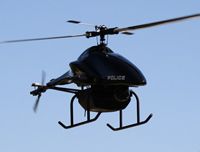
The Sheriff’s Office of Montgomery County, Texas, has a drone thanks to a $300,000 grant from the Department of Homeland Security — it’s built to carry weapons, though the Sheriff says he won’t be using it that way. But that potential use isn’t the only one riling locals. The 50-pound ShadowHawk unmanned vehicle is about the size of (and closely resembles) a large remote-control helicopter. It costs about $40 per hour to operate compared to $500 per hour for the manned alternative. According to the FAA, the county has received a limited Certificate Of Authorization to fly over unpopulated areas at altitudes no more than 400 feet. A report from the Government Accountability Office noted that 65 percent of drone crashes were due to mechanical failure. And practical use of the vehicle’s potential future deployments raises concerns about shared airspace and midairs. Texas civil libertarians have also voiced concerns about invasion of privacy and others are concerned about the drone’s potential to be armed and use force. The Sheriff says he has other plans.
According to Vanguard Defense Industries, the helicopter’s manufacturer, the ShadowHawk can be equipped with Tasers or stun baton bean bag guns. The Montgomery County’s version has no such weaponry. Its vehicle is equipped with forward-looking infrared, and an onboard camera can be switched between day and night vision. It transmits the images in real-time to a small ground-based monitor. The flight controls are actuated via controller and laptop. Sheriff Tommy Gage told reporters Friday that the UAV would be used to hunt criminals who were running from police, or to help SWAT teams assess threatening environments. Gage said also that the helicopter could have found use aiding firefighters during the state’s recent wildfire outbreak. The sheriff said he has no immediate plans to outfit the drone with weapons of any kind and would take all of these concerns, including the potential for midairs, into account when his UAV is working in the field. Over the past four years, drones have found routine use only with the Department of Homeland Security as an active participant in immigration and customs enforcement. At least one such drone crashed after losing contact with its ground-based controller.


































